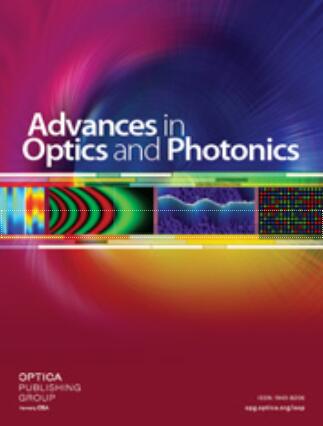非成像光学:教程
IF 23.8
1区 物理与天体物理
Q1 OPTICS
引用次数: 17
摘要
非成像光学是热力学有效光学的理论,因此它更多地依赖于热力学而不是光学。从历史上看,作为理想聚光器的非成像光学是通过诸如“边缘光线渐开线”、“弦法”、“同时多个表面”和“定制边缘光线聚光器”等启发式思想发现的,没有对“理想”的含义进行一致的理论定义。在本教程中,我们提供非成像光学设计的热力学视角,以阐明所有这些设计思想的共性,或者“理想”的非成像设计意味着什么。因此,在本文中,“最佳”设计的条件是基于纯粹的热力学论据提出的,我们相信这有深远的影响。对于初学这门学科的读者来说,热力学也可能是在特定框架内理解或研究它的最直观的方式,而不是从零星的设计方法中学习。这种看待有效集中和照明问题的方式取决于概率、熵的成分和信息论,而传统意义上的“光学”则退隐到背景中。我们试图将非成像光学的关键概念与一些读者可能更熟悉的视点因子的辐射传热概念联系起来。然而,我们不希望限制读者对这个主题的单一热力学理解。因此,非成像光学的两种替代观点也将在整个教程中介绍和使用:根据希尔伯特积分的非成像光学设计的定义,以及理想设计的相空间分析。本教程将组织如下:第1节强调非成像和成像光学之间的区别,第2节描述了非成像光学的热力学理解,第3节介绍了非成像光学的替代相空间表示,第4节描述了使用hotel 's弦的最基本的非成像设计,第5节讨论了几何流线设计方法,第6节总结了非成像光学的各种概念。本文章由计算机程序翻译,如有差异,请以英文原文为准。
Nonimaging optics: a tutorial
Nonimaging optics is the theory of thermodynamically efficient optics and as such, depends more on thermodynamics than on optics. Historically, nonimaging optics that work as ideal concentrators have been discovered through such heuristic ideas as “edge ray involutes,” “string method,” “simultaneous multiple surface,” and “tailored edge ray concentrator,” without a consistent theoretical definition of what “ideal” means. In this tutorial, we provide a thermodynamic perspective of nonimaging optical designs to shine light on the commonality of all these designing ideas, or what “ideal” nonimaging design means. Hence, in this paper, a condition for the “best” design is proposed based purely on thermodynamic arguments, which we believe have profound consequences. Thermodynamics may also be the most intuitive way for a reader who is new to this subject to understand or study it within a certain framework, instead of learning from sporadic designing methodologies. This way of looking at the problem of efficient concentration and illumination depends on probabilities, the ingredients of entropy, and information theory, while “optics” in the conventional sense recedes into the background. We attempt to link the key concept of nonimaging optics, etendue, with the radiative heat transfer concept of view factor, which may be more familiar to some readers. However, we do not want to limit the readers to a single thermodynamic understanding of this subject. Therefore, two alternative perspectives of nonimaging optics will also be introduced and used throughout the tutorial: the definition of a nonimaging optics design according to the Hilbert integral, and the phase space analysis of the ideal design. The tutorial will be organized as follows: Section 1 highlights the difference between nonimaging and imaging optics, Section 2 describes the thermodynamic understanding of nonimaging optics, Section 3 presents the alternative phase space representation of nonimaging optics, Section 4 describes the most basic nonimaging designs using Hottel’s strings, Section 5 discusses the geometric flow line designing method, and Section 6 summarizes the various concepts of nonimaging optics.
求助全文
通过发布文献求助,成功后即可免费获取论文全文。
去求助
来源期刊

Advances in Optics and Photonics
OPTICS-
CiteScore
56.60
自引率
0.00%
发文量
13
期刊介绍:
Advances in Optics and Photonics (AOP) is an all-electronic journal that publishes comprehensive review articles and multimedia tutorials. It is suitable for students, researchers, faculty, business professionals, and engineers interested in optics and photonics. The content of the journal covers advancements in these fields, ranging from fundamental science to engineering applications.
The journal aims to capture the most significant developments in optics and photonics. It achieves this through long review articles and comprehensive tutorials written by prominent and respected authors who are at the forefront of their fields.
The journal goes beyond traditional text-based articles by enhancing the content with multimedia elements, such as animation and video. This multimedia approach helps to enhance the understanding and visualization of complex concepts.
AOP offers dedicated article preparation and peer-review support to assist authors throughout the publication process. This support ensures that the articles meet the journal's standards and are well-received by readers.
Additionally, AOP welcomes comments on published review articles, encouraging further discussions and insights from the scientific community.
In summary, Advances in Optics and Photonics is a comprehensive journal that provides authoritative and accessible content on advancements in optics and photonics. With its diverse range of articles, multimedia enhancements, and dedicated support, AOP serves as a valuable resource for professionals and researchers in these fields.
 求助内容:
求助内容: 应助结果提醒方式:
应助结果提醒方式:


